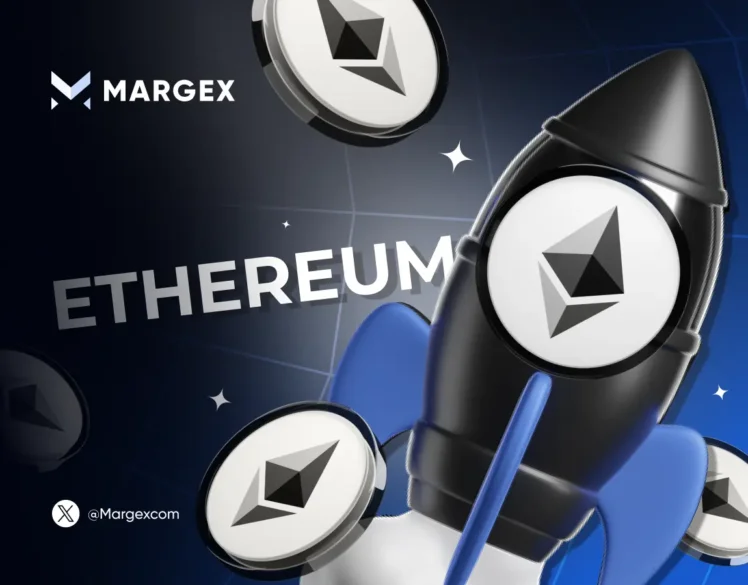Ethereum Poised for 65% Growth This Year, But Sudden Challenges Arise

Over the last year, Ethereum, the second biggest cryptocurrency by market cap, has gone through a real roller-coaster as it dropped from its high of $4,100 reached in December 2024 to a low of $1,750 seen in March. Nevertheless, analysts are predicting a powerful recovery for ETH.
Particularly, they expect a 65% price increase to happen over the coming months. However, despite large investments coming from financial institutions, certain factors may prevent ETH from reaching those projected price levels.
BlackRock’s ETF and whales increase ETH holdings
Ethereum maintains its dominance in the cryptocurrency space and financial institutions have been increasingly betting on its potential in the long run. In a notable development, BlackRock’s USD Institutional Digital Liquidity Fund BUILD has recently increased its ETH holdings and now they constitute almost $1.2 billion. That’s a significant increase from $990 million a week ago.
The situation is different with its spot Ethereum ETF ETHA. Its bag has seen a notable increase despite the overall massive outflows faced by Ethereum spot ETFs. Last week, those comprised $50 million. ETHA currently holds 1,200,000 ETH equal to more than $3.19 billion.
In general, Ethereum ETFs have been lagging behind Bitcoin ETFs, but BlackRock still manages to maintain its leadership not only in Bitcoin but in Ethereum as well.
Aside from the exchange-traded funds, Ethereum has seen a rise in tokenized real-world assets (RWAs), which also boosts its position as a strong and key platform in the crypto space. In addition to being the very first launchpad for new altcoin projects, DeFi apps, NFTs, and meme coins.
Another factor that could be considered bullish for Ethereum, is large ETH holders, frequently referred to as whales. Recently, they have been steadily adding more ETH to their positions. Santiment data reveals that just over the last week alone, Ethereum whales have acquired 470,000 ETH. This development suggests investor confidence in the coin’s future price rise since large investors tend to buy low, expecting long-term price appreciation to lock in profits when it happens.
Overall, since March 12 last year, wallets that hold 1,000 – 10,000 ETH have added 5.65% to their holdings, and wallets with 10,000 – 100,000 ETH have increased by 28.73%.
Aside from that, a major upgrade Pectra is scheduled for Ethereum this year. It was first expected at the end of March but so far it has been postponed until at least late April. When it goes live on the mainnet, it will increase the staking amount of ETH from the current 32 ETH to 2,048 ETH, giving validators more flexibility and increasing the network’s security. Besides, it will enhance user capabilities regarding smart contracts, improving user experience on the network in general.
With his in the pipeline and Ethereum’s strong dominance in the DeFi space, the market sentiment for the second-largest crypto looks positive overall.
Can Ethereum meet bullish expectations this year?
Today, Ethereum has displayed an impressive price surge of roughly 6%, going up from $1,980 to $2,100. Last week, ETH also jumped by more than 9%, surging from $1,877 to $2,057. Those price jumps align with the spikes staged by Bitcoin – 5.51% when it reached the $88,500 zone today and the 6.83% spike added last week.
Still, Ethereum has been facing significant hurdles. Market volatility is a major one of them. Besides, regulatory uncertainty remains a big issue, even though the SEC has labeled Ethereum as a commodity alongside Bitcoin. Ethereum remains an easy target for hackers – the massive $1.2 billion ETH hack faced by the second largest crypto exchange Bybit at the end of February is fine proof of that since the North Korean hackers Lazarus Group exploited an Ethereum smart contract on Bybit.
Besides, as mentioned above, spot Ethereum ETFs lag behind the ones powered by Bitcoin. Samson Mow, the JAN3 CEO and a Bitcoin maximalist has been consistently sharing his bearish take on Ethereum prospects. Last year, before ETH spot ETFs were approved, he predicted that those ETFs would be much less successful than Bitcoin ones since Ethereum locked in ETFs would not bring staking rewards. He revisited that tweet this week, saying that a year ago investors had the last chance to sell ETH above 0.05 BTC.
So far, it seems that even BlackRock would have a hard time pumping ETH up 65% predicted by analysts. So far, the biggest institutional focus remains on Bitcoin rather than Ethereum, if we look at spot ETFs, which represent pretty much all institutional investors. Besides, following the example of Strategy (formerly MicroStrategy), various companies, including Metaplanet, continue to accumulate Bitcoin and hardly anyone company is buying Ethereum. Today, Metaplanet bought 150 BTC, and Strategy, led by Michael Saylor, added 6,911 BTC to their stashes.
Another important factor is that Ethereum founder Vitalik Buterin seems to be somewhat waning within the crypto community with his influence diminishing recently. Even though he remains an important figure, he does not inspire the community the way he did in the early days of ETH.
Overall, even though there are strong factors that could in theory drive an impressive ETH growth later this year, the level of uncertainty remains quite high and investors are keeping an eye on all the recent developments and ETH price movements.


